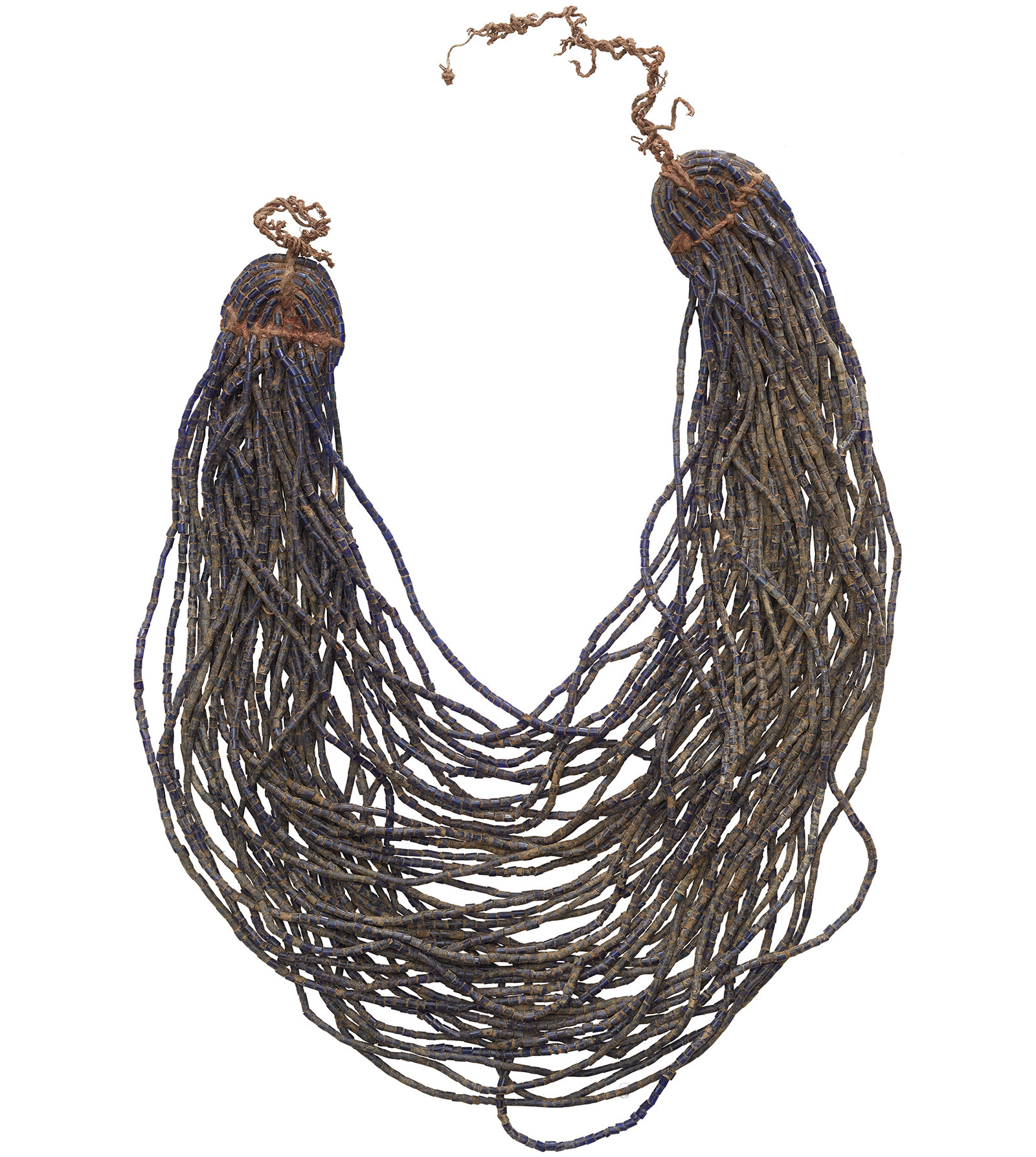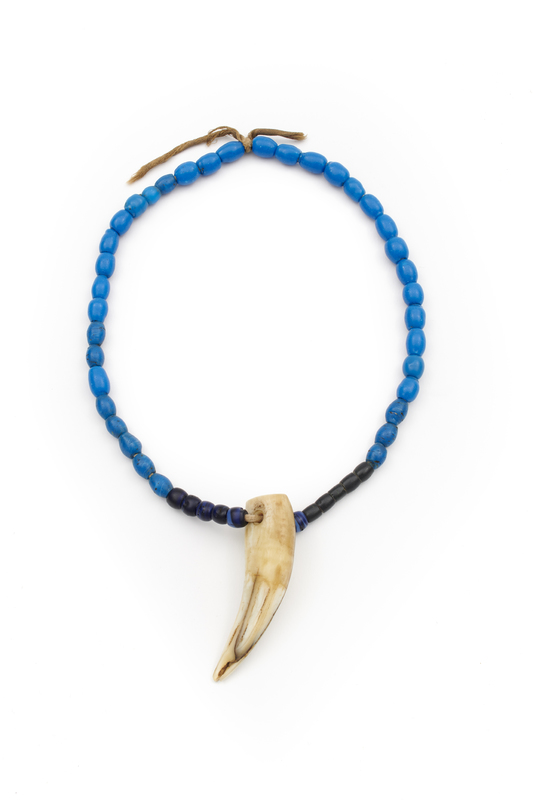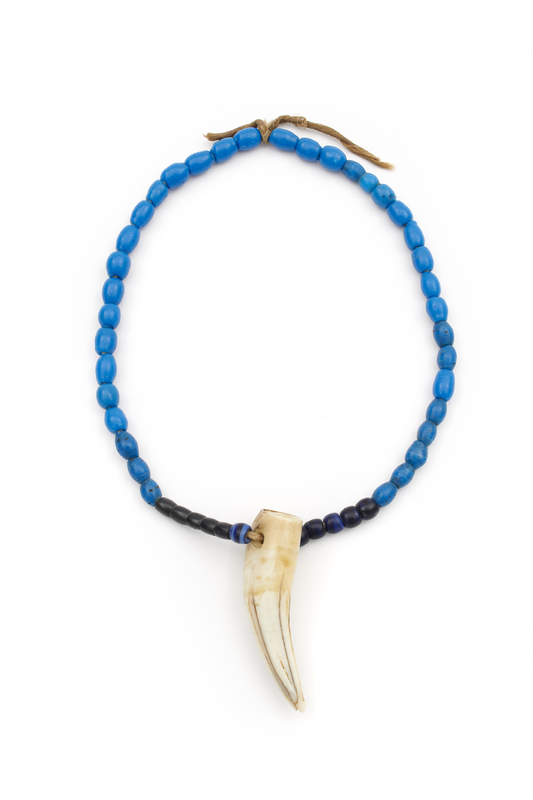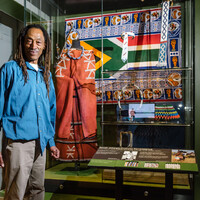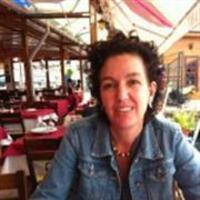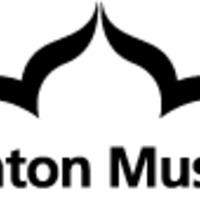Necklace; Pheko
Item
Title
Necklace; Pheko
Creator
Unrecorded
Subject
Body Adornment
Description
Physical Description: This woman's necklace is made of oval blue beads, with darker blue beads at the centre. In the centre of these beads is a pierced leopard's tooth pendant. The leopard's tooth is both a decoration and a charm. All the beads are threaded onto cotton which is tied at both ends. [Royal Pavilion & Museums]
Contextual Description: 01:18:50 I tell him some are saying this is a leopard tooth and he said no, I’m not in agreement with that, its way too huge [discussion about the size]
I asked him if he is familiar with the use of big cat’s parts…is he familiar which that, with people using them to kind of strengthen themselves, yeah those things did exist.
He says the common one today is when you have a child who is grinding their teeth like when they are asleep you know which can be annoying, he says what they would do is take a jaw of a monitor lizard or iguana and take that jaw and make a necklace for this child and that will stop the bad practice of teeth grinding. It’s something that is still done even today. Transcription by KL of MAC_BB_20190817_RPM3 SL Interview with Tshupo Ntono, Village Elder, Language: Setswana with English translations by SL, 2019
I asked him if he is familiar with the use of big cat’s parts…is he familiar which that, with people using them to kind of strengthen themselves, yeah those things did exist.
He says the common one today is when you have a child who is grinding their teeth like when they are asleep you know which can be annoying, he says what they would do is take a jaw of a monitor lizard or iguana and take that jaw and make a necklace for this child and that will stop the bad practice of teeth grinding. It’s something that is still done even today. Transcription by KL of MAC_BB_20190817_RPM3 SL Interview with Tshupo Ntono, Village Elder, Language: Setswana with English translations by SL, 2019
Contextual Description: NS 03:12
Do you think it was likely to be a charm? Or do you think it's just a decoration?
SL 03:17
Because the leopard is like a prized animal. The skin is worn by leaders. And because of that the different parts of that animal, are given, said to have certain powers. You find people making necklaces out of leopards claws.
The above notes are from a transcription by Kathleen Lawther of a discussion between Gase Kediseng, JoAnn McGregor, Nicola Stylianou, Scobie Lekhuthile and Winani Thebele which took place at the Khama III Memorial Museum on the 5th of August 2019. To listen to the full recording please follow the link below.
Do you think it was likely to be a charm? Or do you think it's just a decoration?
SL 03:17
Because the leopard is like a prized animal. The skin is worn by leaders. And because of that the different parts of that animal, are given, said to have certain powers. You find people making necklaces out of leopards claws.
The above notes are from a transcription by Kathleen Lawther of a discussion between Gase Kediseng, JoAnn McGregor, Nicola Stylianou, Scobie Lekhuthile and Winani Thebele which took place at the Khama III Memorial Museum on the 5th of August 2019. To listen to the full recording please follow the link below.
Publisher
Making African Connections
Date
Pre 1899
Type
PhysicalObject
Format
whole: 230 mm
glass; textile cotton; animal tooth
Identifier
R4007/28
Source
Collected by Reverend William Charles Willoughby, a Christian missionary, in what was then the Bechuanaland Protectorate (1885-1966). It is now the Republic of Botswana, having gained independence from Britain in 1966.
From 1889-92 Willoughby was pastor at Union Street Church, Brighton (now The Font pub). From 1893 to 1898 he worked for the London Missionary Society in Bechuanaland. He assembled this collection of objects during this period. This was a period of social and technological changes and these objects represent traditional lifestyles and skills, rather than the contemporary lives of the people Willoughby met.
Willoughby's collection was loaned to Brighton Museum in 1899 when he returned to the UK. The loan was converted into a donation in 1936, and accessioned as acquisition R4007.
Some objects were re-numbered with the WA (World Art) numbering system in the 2000s. These numbers have been reverted to the original R4007/... numbers where possible for consistency in 2019.
This object was on display in the exhibition 'Missionary Collectors' in the James Green Gallery of World Art, from July 2004 to January 2005.
From 1889-92 Willoughby was pastor at Union Street Church, Brighton (now The Font pub). From 1893 to 1898 he worked for the London Missionary Society in Bechuanaland. He assembled this collection of objects during this period. This was a period of social and technological changes and these objects represent traditional lifestyles and skills, rather than the contemporary lives of the people Willoughby met.
Willoughby's collection was loaned to Brighton Museum in 1899 when he returned to the UK. The loan was converted into a donation in 1936, and accessioned as acquisition R4007.
Some objects were re-numbered with the WA (World Art) numbering system in the 2000s. These numbers have been reverted to the original R4007/... numbers where possible for consistency in 2019.
This object was on display in the exhibition 'Missionary Collectors' in the James Green Gallery of World Art, from July 2004 to January 2005.
William Charles Willoughby
Botswana, Southern Africa, Africa
1893-1898
Space/Place
Botswana, Southern Africa, Africa
Cultural Group: Tswana
Rights
Creative Commons Attribution-ShareAlike 4.0 International

